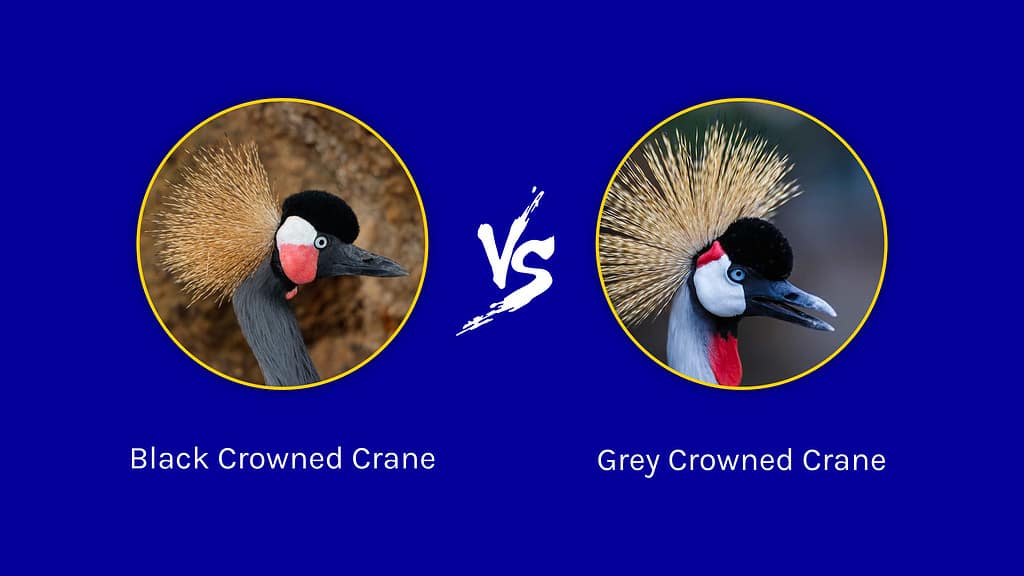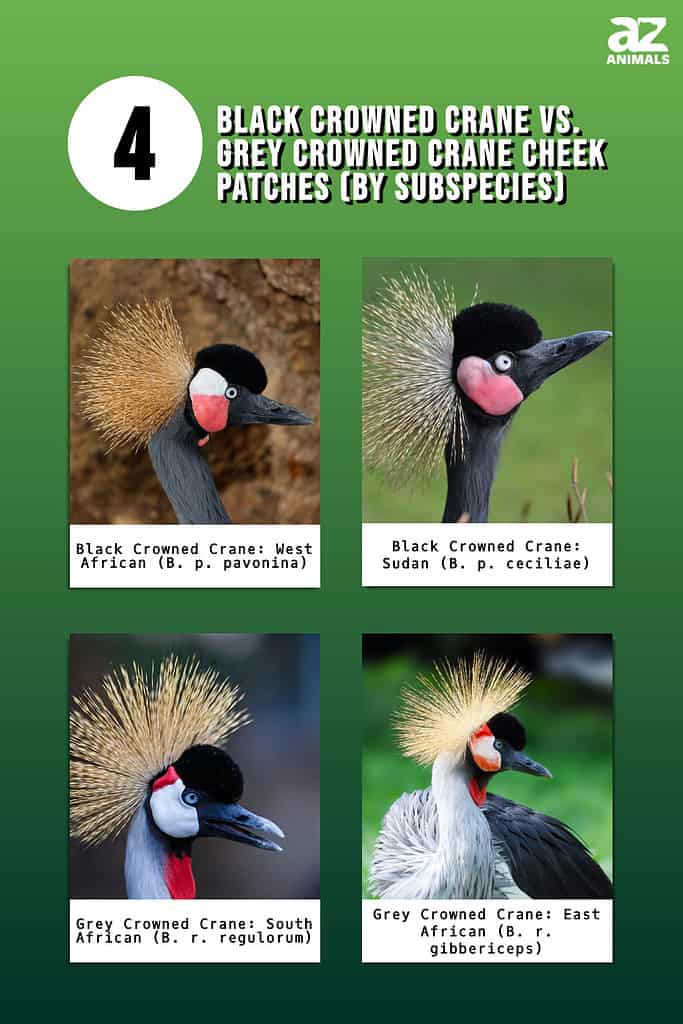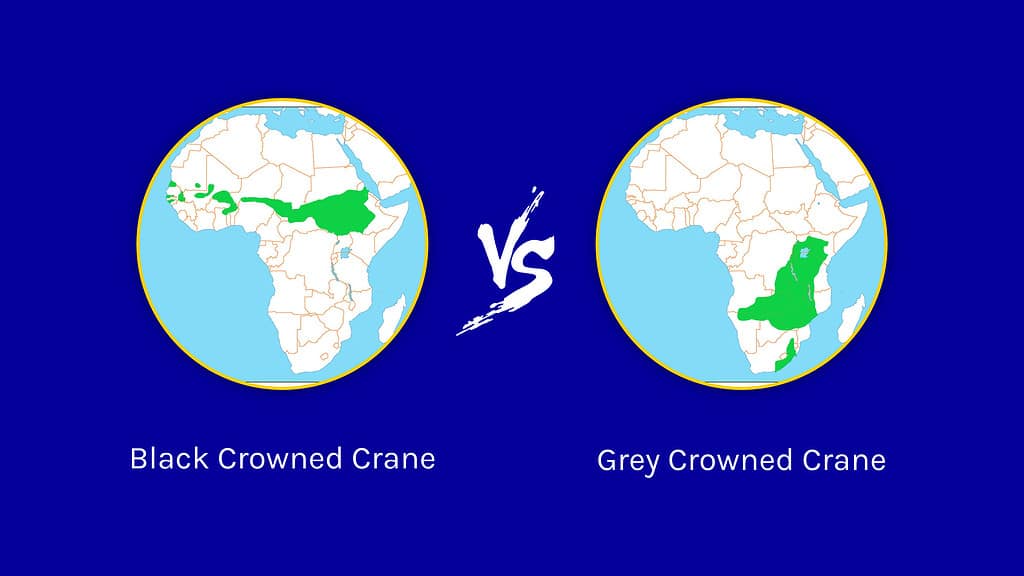There are two species of African crowned cranes (Balearica spp.), each further divided into two subspecies:
- Black Crowned Crane (Balearica pavonina)
- Sudan Crowned Crane (B. p. ceciliae)
- West African Crowned Crane (B. p. pavonina)
- Grey Crowned Crane (Balearica regulorum)
- East African Crowned Crane (B. r. gibbericeps)
- South African Crowned Crane (B. r. regulorum)
These two closely related sister species cranes share an overall similar appearance and life history. However, several key differences distinguish the two crowned crane species and their respective subspecies, including differences in body/neck color, gular sac size, cheek patches, geographic range, use as a national symbol, and conservation status. Read on to learn what makes each unique!
Black Crowned Crane vs. Grey Crowned Crane: Body/Neck Color

Both crowned crane species have grayish bodies with white wing patches tinged with straw tones; dark gray bare parts (bills, legs, and feet); flashes of red on their faces and necks; and of course, those fabulous golden crowns of bristle-like feathers for which they are named. As their respective common names suggest, however, the black crowned crane tends to have darker slate gray to blackish plumage, while the grey-crowned crane tends to be a lighter pearly gray. This difference is especially evident in their neck plumage.
Black Crowned Crane vs. Grey Crowned Crane: Gular Sacs

Both crowned cranes have inflatable red pouches on their throats, known as gular sacs. However, the black crowned crane has a much smaller one, sometimes barely even visible. In contrast, the grey crowned crane has a larger one that hangs off the neck.
Black Crowned Crane vs. Grey Crowned Crane: Cheek Patches

Both the black crowned crane and grey crowned crane have cheek patches with red and white coloration. The specific color differences seen in the top and bottom halves help distinguish not only the two species but each of those species’ two subspecies as well. In each case, there is one subspecies where the red and white are clearly delineated and one where the red seems to bleed into the white area more.
Black Crowned Cranes
Black crowned cranes have cheek patches that are red on the bottom and white on the top. In the West African subspecies, this division is usually a fairly even half-and-half. However, in the Sudan subspecies, the red extends over the halfway point, sometimes occupying nearly all of the upper half.
Grey Crowned Cranes
Grey crowned cranes have the opposite cheek patch color scheme, with red on the top and white on the bottom. In the South African subspecies, this usually takes the form of a distinct red bar well above the eye, with the rest white. However, in the East African subspecies, there is often additional red interspersed in the white area.
Black Crowned Crane vs. Grey Crowned Crane: Geographic Range

Both the black crowned crane and the grey crowned crane are endemic to continental Africa. Both utilize a similar mixture of wetland and grassland habitats and are noteworthy for being the only crane species that can roost in trees thanks to their long hind toes! However, each species (and each of its subspecies) is found in different regions of Africa, as shown below.
Black-Crowned Cranes
The black crowned crane is found across the Sahel and Sudan-Guinea savanna zones of Sub-Saharan Africa. The West African subspecies occupies the western half of this range, and the Sudan subspecies occupies the eastern half.
Grey Crowned Cranes
The grey crowned crane is found in Eastern and Southern Africa. The East African subspecies ranges from the Democratic Republic of the Congo, Rwanda, Uganda, and Kenya south through Tanzania to Mozambique. The Southern African subspecies ranges from Mozambique south through Zimbabwe to South Africa and west to Namibia and Angola.
Black Crowned Crane vs. Grey Crowned Crane: Use As a National Symbol

Uganda’s flag features an East African crowned crane emblem.
©Osman Bugra Nuvasil/Shutterstock.com
Each crowned crane species is the national bird of a different African country. The black crowned crane is the national bird of Nigeria, and the grey crowned crane is the national bird of Uganda. Uganda specifically designates the East African crowned crane subspecies as its official bird symbol and features a stylized emblem of it on both its flag and coat of arms.
Black Crowned Crane vs. Grey Crowned Crane: Conservation Status

The continued loss and degradation of wetlands habitats that crowned cranes rely on for breeding threatens both species.
©imageBROKER.com/Shutterstock.com
Unfortunately, both crowned crane species are currently threatened, but one more so than the other. The IUCN Red List currently lists the black-crowned crane as Vulnerable, and the gray-crowned crane as Endangered. For both species, habitat loss and degradation are top threats, along with hunting (for food) and trapping (for trade).
Black Crowned Crane vs. Grey Crowned Crane: Summary of Key Differences
| Black Crowned Crane | Grey Crowned Crane | |
|---|---|---|
| Body/Neck Color | darker gray | lighter gray |
| Red Gular Sac | small, often barely visible | large, hanging |
| Cheek Patches | white on top, red on bottom B. p. pavonina: fairly even half-red and half-white B. p. ceciliae: more than half red | red on top, white on bottom B. r. regulorum: distinct smaller area of red on top B. r. gibbericeps: additional red interspersed in white area |
| Geographic Range | Sahel & Sudan-Guinea savanna zones of Sub-Saharan Africa East: B. p. ceciliae West: B. p. pavonina | Eastern & Southern Africa East: B. r. gibbericeps South: B. r. regulorum |
| National Bird Symbol | Nigeria | Uganda |
| Conservation Status | Vulnerable | Endangered |
The photo featured at the top of this post is ©
Thank you for reading! Have some feedback for us? Contact the AZ Animals editorial team.






